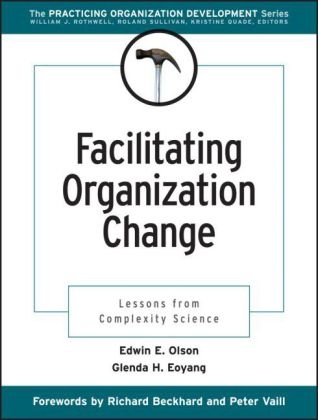Read more
Informationen zum Autor Edwin E. Olson , PhD, earned a master's degree in pastoral counseling and a PhD in government. He teaches organization behavior at the University of Maryland, University College. Glenda H. Eoyang is the author of Facilitating Organization Change: Lessons from Complexity Science , published by Wiley. Klappentext "Facilitating Organization Change" hilft Ihnen, die Dynamik des Wandels in einem komplexen System zu verstehen und diese Kräfte gezielt zu nutzen. Dieses Buch nennt neue Perspektiven, Methoden und Techniken zur Wiederbelebung von Unternehmen. Es erläutert auch die Muster die das Unternehmensverhalten steuern und zeigt, wie man sich diese Einsichten zunutze macht, um den Unternehmenswandel effektiver voranzutreiben. Zusammenfassung Leaders and facilitators of organization and system change know intuitively that the context of the work is complex and adaptive, but most have not been exposed to the concepts of complexity science. Without a language and a set of models, they find it difficult to understand or make use of the complexity that inevitably surrounds them. Inhaltsverzeichnis List of Tables, Figures, and Exhibits ix Foreword to the Series xi Introduction to the Series xiii Statement of the Board xvii Foreword xxiii Dedication xxx Preface xxxi Acknowledgments xxxix Self-Diagnosis xli 1. An Emerging Paradigm of Organization Change 1 Organization As Machine 2 Problem with Traditional Approaches 4 Alternatives to the Machine Model 6 Toward an Integrated Framework 7 From the Part to the Whole 10 From the Whole to the Part 10 Emergent Patterns Through Self-Organization 11 Conditions for Self-Organization 11 The Self-Organizing Process 15 No Condition Stands Alone 16 CAS and the Change Agent 18 Summary 19 Method: Self-Organizing Dynamics 20 2. Change Through Connections (Not Top-Down Control) 25 Story: Hospital Merger 26 Entangled Connections 27 No Single Source of Change 29 Leadership and Influence in a CAS 31 Role of Formal Leader 33 Change Agent Role 37 Summary 39 Method: Feedback Analysis 40 Method: Leader As Change Agent 45 3. Adapt to Uncertainty (Not Predictable Stages of Development) 49 Nonlinear Organization Change 51 Story: Unpredictability vs. Need for Control 52 Consulting to Uncertainty 54 No Sequence of Events 55 Speed of Adaptation 56 Change Agent Role 60 Summary 62 Method: Decision Making Under Conditions of Uncertainty 63 4. Emerging Goals, Plans, and Structures (Not Clear, Detailed Plans or Goals) 69 Case: Knowledge Management Firms 71 Planning in a CAS 72 Vision in a CAS 73 Goal Setting in a CAS 75 Structures in a CAS 75 Change Agent Role 80 Summary 81 Method: Self-Organizing Exercise 81 5. Amplify Difference (Not Build Consensus) 85 Story: The Hidden Difference 86 Unbraiding Differences 88 Differences in a CAS 89 Differences and Organization Resilience 90 Differences and Organization Change 91 Change Agent Role 93 Summary 94 Method: Difference Matrix 95 6. Self-Similarity (Not Differences Between Levels) 101 Story: The Hidden Difference (Continued) 102 Self-Similarity in Organizations 103 Scaling 104 Scaling in Organizations 104 Simple Rules 106 Change Agent Role 107 Summary 108 Method: Fractal As Metaphor 108 7. Success As Fit with the Environment (Not Closing the Gap with an Ideal) 115 Story: Focusing on Fit 116 Success As Fitness 118 Performance Feedback 121...

